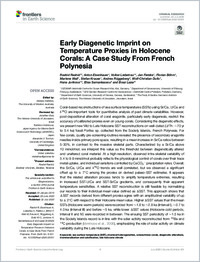Early diagenetic imprint on temperature proxies in holocene corals: a case study from french polynesia
- Rashid, Rashid GEOMAR Helmholtz Centre for Ocean Research Kiel, Kiel, Germany
- Eisenhauer, Anton GEOMAR Helmholtz Centre for Ocean Research Kiel, Kiel, Germany
- Liebetrau, Volker GEOMAR Helmholtz Centre for Ocean Research Kiel, Kiel, Germany
- Fietzke, Jan GEOMAR Helmholtz Centre for Ocean Research Kiel, Kiel, Germany
- Böhm, Florian GEOMAR Helmholtz Centre for Ocean Research Kiel, Kiel, Germany
- Wall, Marlene GEOMAR Helmholtz Centre for Ocean Research Kiel, Kiel, Germany
- Krause, Stefan GEOMAR Helmholtz Centre for Ocean Research Kiel, Kiel, Germany
- Rüggeberg, Andres Department of Geosciences, University of Fribourg, Fribourg, Switzerland
- Dullo, Wolf-Christian GEOMAR Helmholtz Centre for Ocean Research Kiel, Kiel, Germany
- Jurikova, Hana GEOMAR Helmholtz Centre for Ocean Research Kiel, Kiel, Germany - GFZ German Research Centre for Geosciences – Helmholtz Centre Potsdam, Potsdam, Germany
- Samankassou, Elias Department of Earth Sciences, University of Geneva, Geneva, Switzerland
- Lazar, Boaz The Fredy & Nadine Herrmann Institute of Earth Sciences, The Hebrew University of Jerusalem, Jerusalem, Israel
- 22.07.2020
Published in:
- Frontiers in Earth Science. - 2020, vol. 8, p. 301
English
Coral-based reconstructions of sea surface temperatures (SSTs) using Sr/Ca, U/Ca and δ18O ratios are important tools for quantitative analysis of past climate variabilities. However, post-depositional alteration of coral aragonite, particularly early diagenesis, restrict the accuracy of calibrated proxies even on young corals. Considering the diagenetic effects, we present new Mid to Late Holocene SST reconstructions on well-dated (U/Th: ~70 yr to 5.4 ka) fossil Porites sp. collected from the Society Islands, French Polynesia. For few corals, quality pre-screening routines revealed the presence of secondary aragonite needles inside primary pore space, resulting in a mean increase in Sr/Ca ratios between 5−30%, in contrast to the massive skeletal parts. Characterised by a Sr/Ca above 10 mmol/mol, we interpret this value as the threshold between diagenetically altered and unaltered coral material. At a high-resolution, observed intra-skeletal variability of 5.4 to 9.9 mmol/mol probably reflects the physiological control of corals over their trace metal uptake, and individual variations controlled by CaCO3– precipitation rates. Overall, the Sr/Ca, U/Ca and δ18O trends are well correlated, but we observed a significant offset up to ± 7 °C among the proxies on derived palaeo-SST estimates. It appears that the related alteration process tends to amplify temperature extremes, resulting in increased SST- U/Ca and SST-Sr/Ca gradients, and consequently their apparent temperature sensitivities. A relative SST reconstruction is still feasible by normalising our records to their individual mean value defined as ΔSST. This approach shows that ΔSST records derived from different proxies agree with an amplitudinal variability of up to ± 2 °C with respect to their Holocene mean value. Higher ΔSST values than the mean SSTs (Holocene warm periods) were recorded from ~1.8 to ~2.8 ka (Interval I), ~3.7 to 4.0 ka (Interval III) and before ~5 ka, while lower ΔSST values (Holocene cold periods, Interval II and IV) were recorded in between. The ensuing SST periodicity of ~1.5 ka in the Society Islands record is in line with the solar activity reconstructed from 10Be and 14C production (Vonmoos et al., 2006), emphasizing the role of solar activity on climate variability during the Late Holocene.
- Faculty
- Faculté des sciences et de médecine
- Department
- Département de Géosciences
- Language
-
- English
- Classification
- Meteorology, climatology
- License
-
License undefined
- Identifiers
-
- RERO DOC 328923
- DOI 10.3389/feart.2020.00301
- Persistent URL
- https://folia.unifr.ch/unifr/documents/308835
Statistics
Document views: 149
File downloads:
- pdf: 210
